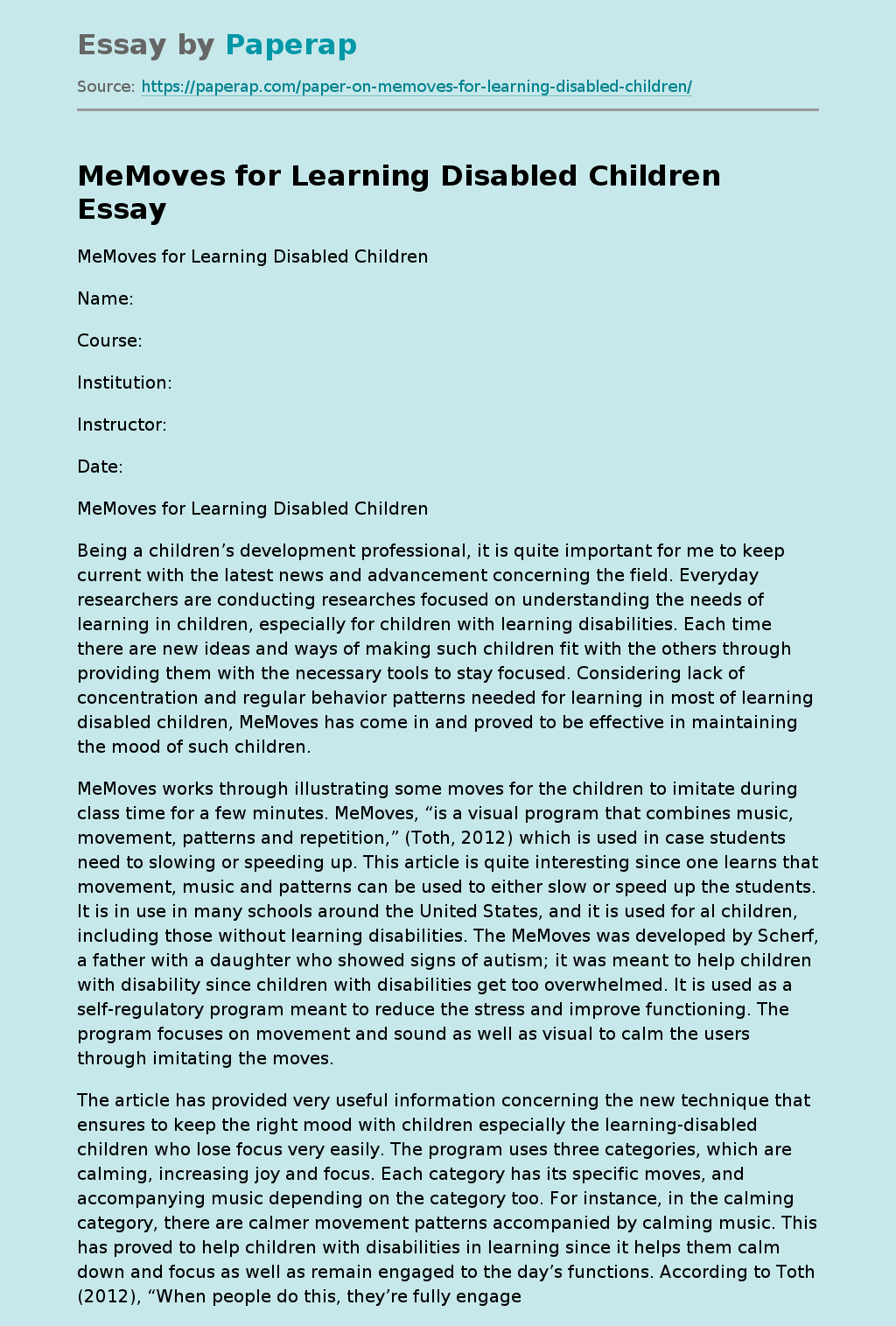MeMoves for Learning Disabled Children
MeMoves for Learning Disabled Children
Name:
Course:
Institution:
Instructor:
Date:
MeMoves for Learning Disabled Children
Being a children’s development professional, it is quite important for me to keep current with the latest news and advancement concerning the field. Everyday researchers are conducting researches focused on understanding the needs of learning in children, especially for children with learning disabilities. Each time there are new ideas and ways of making such children fit with the others through providing them with the necessary tools to stay focused.
Considering lack of concentration and regular behavior patterns needed for learning in most of learning disabled children, MeMoves has come in and proved to be effective in maintaining the mood of such children.
MeMoves works through illustrating some moves for the children to imitate during class time for a few minutes. MeMoves, “is a visual program that combines music, movement, patterns and repetition,” (Toth, 2012) which is used in case students need to slowing or speeding up.
This article is quite interesting since one learns that movement, music and patterns can be used to either slow or speed up the students. It is in use in many schools around the United States, and it is used for al children, including those without learning disabilities. The MeMoves was developed by Scherf, a father with a daughter who showed signs of autism; it was meant to help children with disability since children with disabilities get too overwhelmed. It is used as a self-regulatory program meant to reduce the stress and improve functioning.
The program focuses on movement and sound as well as visual to calm the users through imitating the moves.
The article has provided very useful information concerning the new technique that ensures to keep the right mood with children especially the learning-disabled children who lose focus very easily. The program uses three categories, which are calming, increasing joy and focus. Each category has its specific moves, and accompanying music depending on the category too. For instance, in the calming category, there are calmer movement patterns accompanied by calming music. This has proved to help children with disabilities in learning since it helps them calm down and focus as well as remain engaged to the day’s functions. According to Toth (2012), “When people do this, they’re fully engaged — physically, cognitively, visually, auditorally, … You’re so fully engaged that there’s no bandwidth left for distractions.” With such a program, teaching children with disabilities is easier since keeping them focused and calm to remain participative in class is easily achievable.
The article talks about the program working for an inclusive class, which means there are both children with learning disabilities and those without. There has been a myth in the past that children with learning disabilities need special education unlike that which is offered to normal children. However, the article has illustrated that even such children are capable of learning what other normal children can learn with a little help. There are other misconceptions from people concerning the ability of children with disabilities to learn or listen. The article provides evidence that even autistic children can learn and lead normal lives just like Scherf’s daughter. The article makes it clear that children with disabilities in learning are not abnormal, and can fit within the society just like other kids with normal capabilities.
From the article, it is obvious that the individuality of the children mentioned is mixed, where it can be normal child with all learning capabilities, or children with learning disabilities. The article however, does not specify any individuality or suggest any individuality of children, rather, it only states about their general character. The article states that children with disabilities are easily overwhelmed than those who are completely normal. This suggests that children with disabilities are more sensitive than other children, and need more calming and stress reduction more often than other children need.
References
Toth, S. (2012). At Clarksville Elementary, movement brings calm, focus. Retrieved from: http://www.baltimoresun.com/explore/howard/news/ph-ho-cf-school-days-0308-20120301,0,6974291.story
MeMoves for Learning Disabled Children. (2019, Feb 07). Retrieved from https://paperap.com/paper-on-memoves-for-learning-disabled-children/

